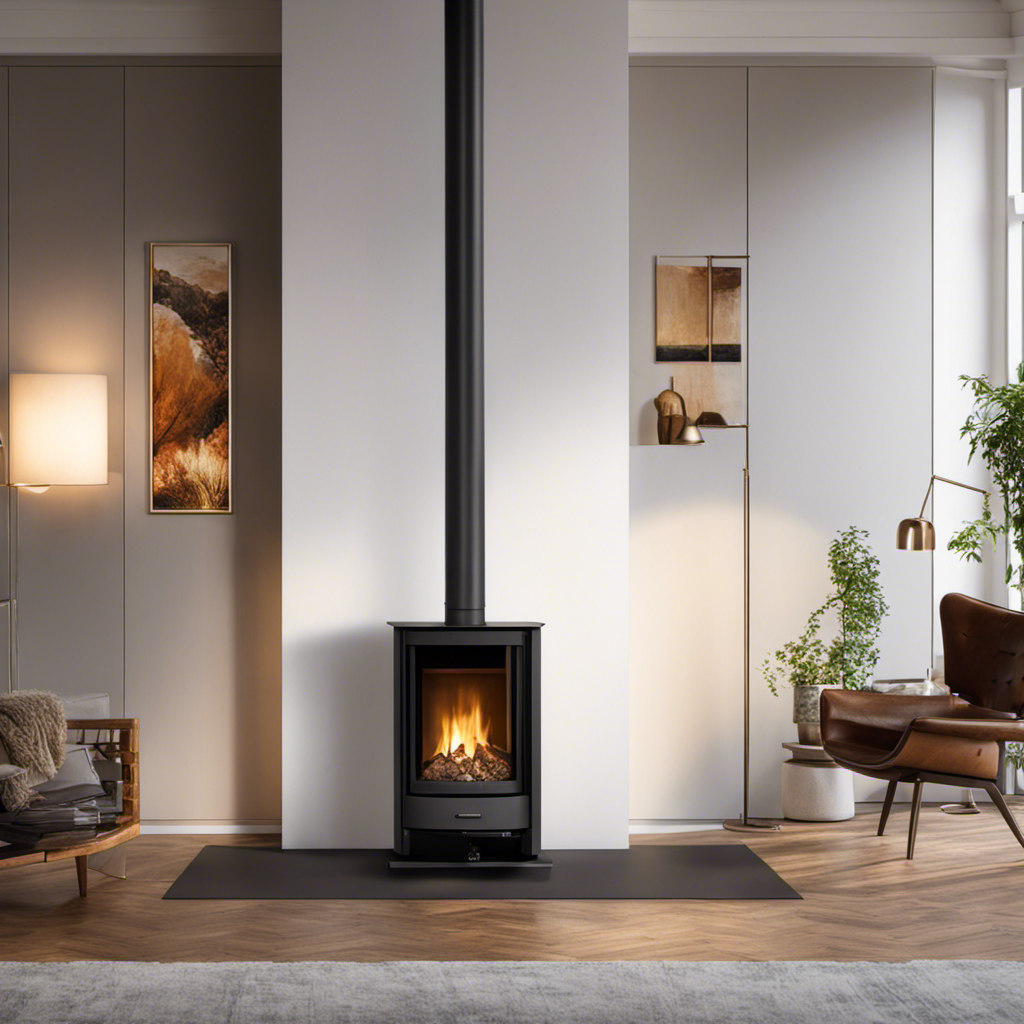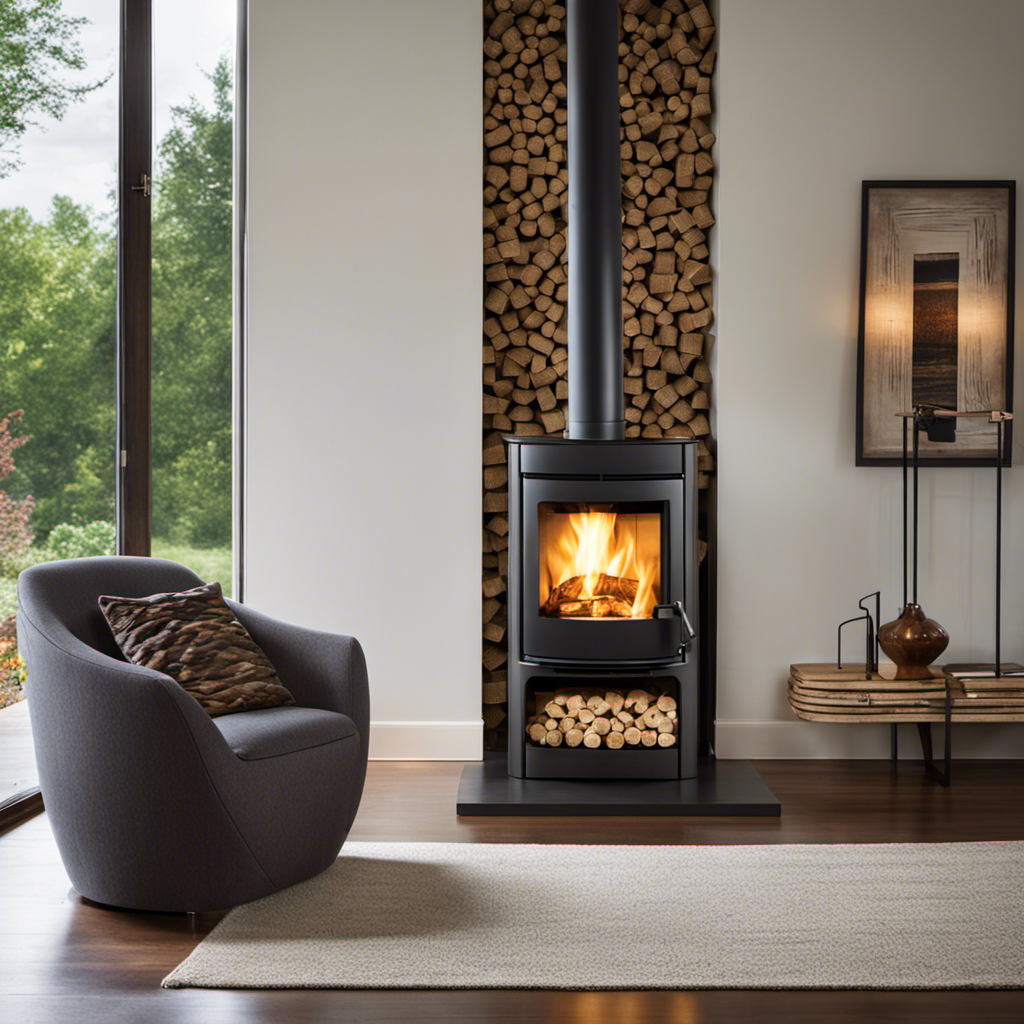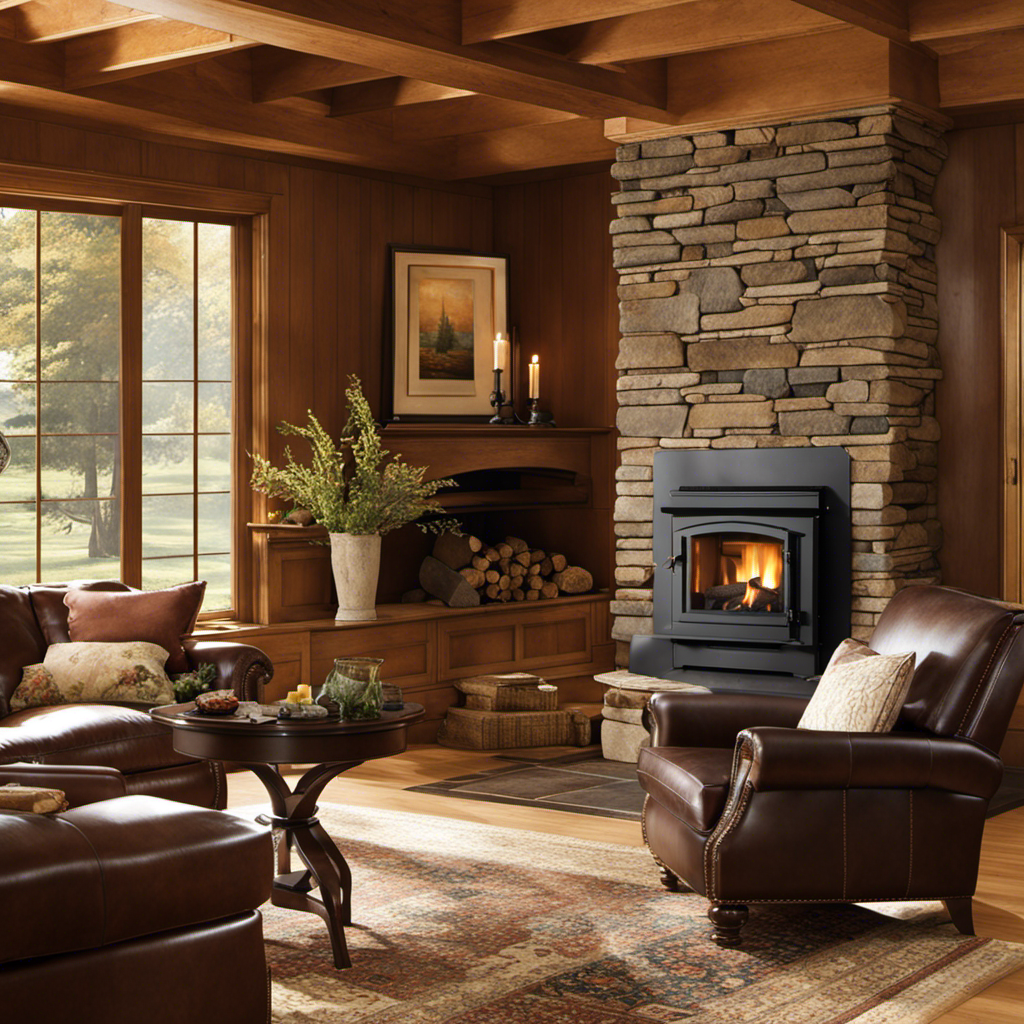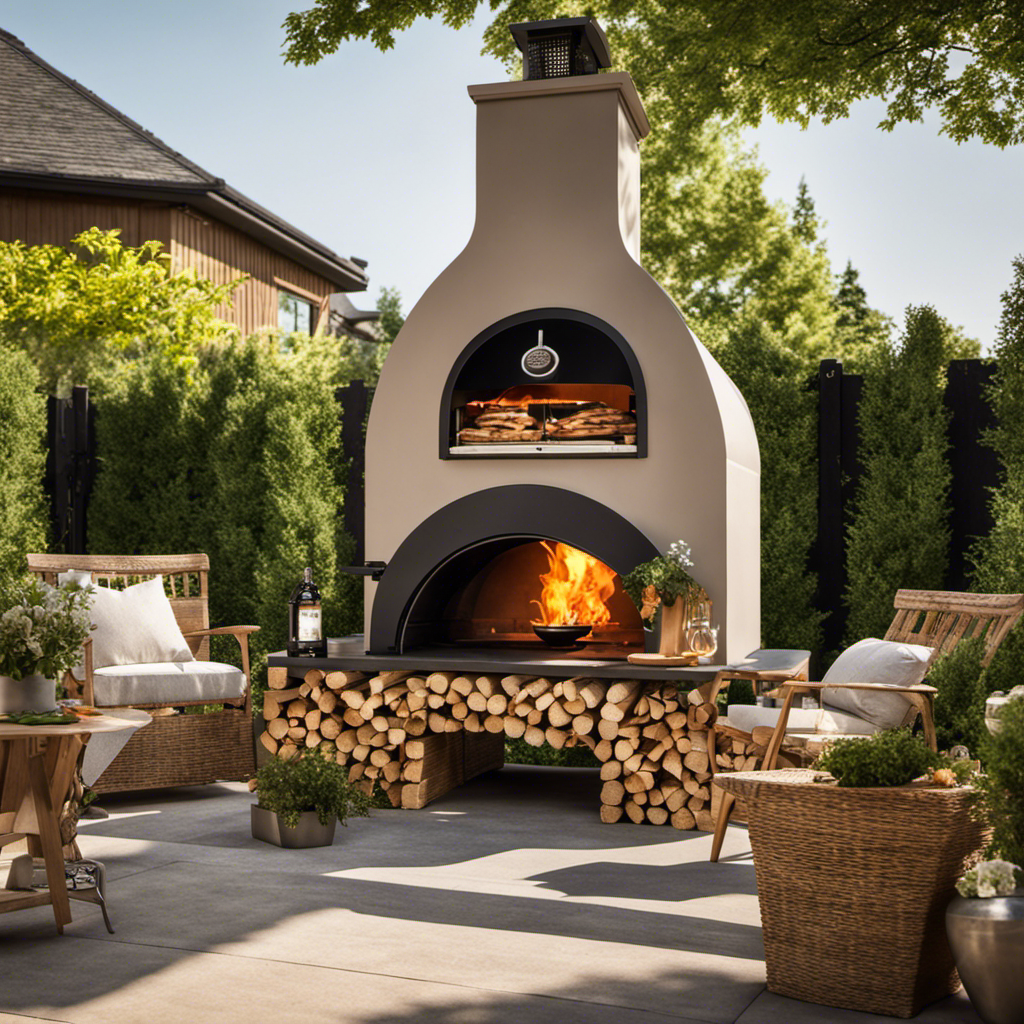Fed up with the inconvenience and mess that come with traditional wood stoves? Look no further, because we have the perfect answer: pellet stoves. These innovative devices are transforming the approach to home heating.
In this article, we’ll explore the convenience, efficiency, costs, and maintenance of pellet stoves. We’ll even compare them to traditional wood stoves to help you decide which option is right for you.
So, let’s dive into the world of pellet stoves and unleash their power in home heating.
Key Takeaways
- Pellet stoves offer convenience and efficiency with minimal user input required.
- They are a more environmentally friendly option compared to traditional wood stoves.
- Pellet stoves can heat a home for less than $1 per day, making them cost-effective.
- However, they require electricity to operate and have a higher upfront cost compared to wood stoves.
The Convenience and Efficiency of Pellet Stoves
The convenience and efficiency of pellet stoves make them a practical and user-friendly option for home heating. Pellet stove operation is incredibly easy, as these stoves operate automatically, requiring minimal user input. With most pellet stoves, you can go for 24 hours or more without needing to refill them, thanks to the self-igniting and self-extinguishing features.
No regular adding of wood or removal of ashes is required, making maintenance hassle-free. These stoves burn pellets made from compressed sawdust or other wood waste, producing very little ash during combustion.
In addition, some pellet stoves can heat a home for less than $1 per day, making them not only efficient but also cost-effective. The automation of pellet stoves ensures a convenient and effortless heating experience for homeowners.
Cost and Maintenance Considerations
When considering cost and maintenance, we need to take into account factors such as the price of pellets and the frequency of cleaning required for pellet stoves. Pellet stove maintenance is an important aspect to consider when evaluating the overall cost of owning and operating a pellet stove. While the convenience and efficiency of pellet stoves are undeniable, it is essential to factor in the additional costs and maintenance requirements.
To give you a better idea of the cost comparison with other heating options, here is a table that compares the maintenance needs and costs of pellet stoves with other popular heating options:
| Heating Option | Maintenance Required | Cost |
|---|---|---|
| Pellet Stove | Regular cleaning due to small size of pellets | Pellets can be more expensive |
| Wood Stove | Manual building and lighting of each fire | Firewood can often be sourced from your own property |
| Electric Heater | Minimal maintenance required | Higher electricity costs |
As you can see, pellet stoves do require more frequent cleaning due to the small size of the pellets, and the cost of pellets can be higher compared to firewood. However, the convenience and efficiency of pellet stoves often outweigh the additional maintenance needs and costs, making them a popular choice for many homeowners.
Pros of Using a Pellet Stove
Using a pellet stove offers us the benefits of high automation, clean burning, and a renewable fuel source.
Pellets, made from compressed sawdust or other wood waste, are the fuel options for pellet stoves. They’re a renewable and often recycled material, making them an eco-friendly choice.
Pellet stoves are easy to use with automatic heating and temperature control features, providing convenience and efficiency.
When it comes to maintenance, pellet stoves require more frequent cleaning due to the small size of the pellets. However, the convenience and efficiency of pellet stoves outweigh any extra costs or maintenance needs.
Overall, pellet stoves provide a clean and efficient way to heat our homes, while also being environmentally friendly.
Cons of Using a Pellet Stove
Cons of using a pellet stove include:
- The need for electricity to operate
- The inability to source fuel from our own property
- The potential for more frequent cleaning due to the small size of the pellets
Operational drawbacks of a pellet stove include:
- Reliance on electricity to function, making it unusable during a power outage without a backup power source
- Requirement of specially made pellets as fuel, which can’t be sourced from our own property like traditional wood logs
- Noise levels can also be a concern, as pellet stoves produce some noise due to their electrical and moving parts
It’s important to consider these operational drawbacks and noise levels when deciding if a pellet stove is the right choice for your home heating needs.
Comparing Pellet Stoves to Wood Stoves
In terms of efficiency and cost-effectiveness, we find that pellet stoves outperform wood stoves. When comparing pellet stoves to traditional wood stoves, there are several key differences to consider.
Firstly, pellet stoves operate automatically, requiring minimal user input and can go for 24 hours or more without needing to be refilled. They also burn pellets made from compressed sawdust or other wood waste, producing very little ash during combustion.
Pellet stoves are more efficient and environmentally friendly compared to traditional wood stoves, with some models capable of heating a home for less than $1 per day. However, it’s important to note that pellets can be more expensive than other solid fuels, and pellet stoves require more frequent cleaning due to the small size of the pellets.
Despite these factors, the convenience and efficiency of pellet stoves outweigh any extra costs or maintenance needs.
Installation Options for Pellet Stoves
When it comes to installation options, we’ve found that pellet stoves offer more flexibility than other forms of wood stoves. Pellet stoves can be vented through an existing chimney or direct-vented through an exterior wall, providing more options for homeowners. This versatility is beneficial for those who may not have access to a chimney or prefer not to use one.
Additionally, pellet stoves have fewer strict installation requirements compared to other types of wood stoves. This means that homeowners have more freedom in choosing the location for their pellet stove.
When it comes to ventilation options, pellet stoves offer more choices and adaptability, making them a convenient and efficient heating option for many households.
Environmental Benefits of Pellet Stoves
One of the environmental benefits of pellet stoves is that they produce low emissions, making them a cleaner option for heating our homes. Here are the benefits of pellet stoves over traditional heating methods and the impact they have on reducing carbon emissions:
-
Reduced carbon emissions: Pellet stoves burn pellets made from compressed sawdust or other wood waste, resulting in lower carbon emissions compared to traditional wood stoves or fossil fuel-based heating systems. This helps to mitigate the negative impact on our environment and climate.
-
Renewable fuel source: Pellets are made from renewable and often recycled materials, such as sawdust or agricultural waste. By using these materials, pellet stoves contribute to a more sustainable and circular economy.
-
Efficient and cost-effective: Pellet stoves are highly efficient, with some models capable of heating a home for less than $1 per day. This not only saves money on heating costs but also reduces the demand for fossil fuels, further reducing carbon emissions.
-
Improved air quality: Pellet stoves produce less smoke and smell compared to traditional wood stoves, making them better for indoor air quality. This is especially beneficial for individuals with respiratory conditions or allergies.
Pellet Stoves: A Cost-Effective Heating Solution
By choosing a pellet stove, we can save money on heating costs and enjoy a cost-effective solution for keeping our homes warm.
Pellet stoves offer significant cost savings compared to traditional heating options. These stoves burn pellets made from compressed sawdust or wood waste, which are often more affordable than other solid fuels.
Additionally, pellet stoves are more efficient and environmentally friendly. They produce minimal ash during combustion and have low emissions, reducing their environmental impact.
With their high automation and self-igniting features, pellet stoves require minimal user input and can operate for long periods without needing to be refilled.
While there may be higher upfront costs and more frequent cleaning required, the convenience, efficiency, and cost savings of pellet stoves outweigh any additional expenses.
Overall, pellet stoves provide a cost-effective heating solution that benefits both our wallet and the environment.
Tips for Maximizing the Performance of Your Pellet Stove
When it comes to maximizing the performance of your pellet stove, there are a few key tips to keep in mind. Proper cleaning and maintenance play a crucial role in ensuring your stove operates efficiently and effectively.
Here are some tips to help you troubleshoot any issues and keep your pellet stove in top condition:
-
Regularly clean the hopper and burn pot: Remove any leftover pellets and ash buildup to prevent clogs and maintain proper airflow.
-
Check the exhaust vent: Make sure the vent is clear of any debris or obstructions that could restrict airflow and affect performance.
-
Clean the glass door: Use a non-abrasive cleaner to remove any soot or residue from the glass, allowing for a clear view of the flames.
-
Schedule professional maintenance: Consider having your pellet stove inspected and serviced annually by a certified technician to address any potential issues and ensure optimal performance.
Frequently Asked Questions
Can Pellet Stoves Be Used Without Electricity?
Pellet stoves can’t be used without electricity. This is one of the major disadvantages of pellet stoves, as they rely on electricity to operate. Unlike wood stoves, which can be used off-grid, pellet stoves require a power source to run.
This means that during a power outage, the pellet stove won’t function unless there’s a backup power supply. This limitation should be taken into consideration when deciding on alternative heating options for off-grid living.
Are There Any Health Risks Associated With Using a Pellet Stove?
There are no significant health risks associated with using a pellet stove. In fact, there are potential health benefits compared to traditional wood stoves.
Pellet stoves burn clean and produce low emissions, which improves indoor air quality. They also have a positive environmental impact, as pellets are made from renewable and often recycled materials.
Overall, pellet stoves offer a safe and sustainable heating option for homes.
How Often Should a Pellet Stove Be Cleaned?
We recommend cleaning a pellet stove at least once a month to ensure optimal performance. Regular cleaning helps prevent ash buildup and keeps the stove running efficiently.
Start by turning off the stove and allowing it to cool down. Then, remove the ash pan and empty it. Use a brush to clean the burn pot and remove any ash or debris.
Clean the glass door with a glass cleaner, and vacuum or brush the venting system. Regular maintenance like this will help your pellet stove last longer and operate at its best.
Can Pellet Stoves Be Used in Areas With Strict Air Quality Regulations?
Pellet stoves can be used in areas with strict air quality regulations. While they do produce some emissions, pellet stoves have lower emissions compared to traditional wood stoves. This is due to the clean burning nature of pellets made from compressed sawdust or other wood waste.
The environmental benefits of pellet stoves include reduced air pollution and improved indoor air quality. However, it’s important to ensure that the pellets used meet any specific regulations set forth by local authorities.
Are There Any Government Incentives or Rebates Available for Purchasing a Pellet Stove?
Yes, there are government incentives and rebates available for purchasing a pellet stove. These incentives and rebates vary depending on your location and the specific program in place. They’re designed to encourage the use of pellet stoves as a more environmentally friendly and efficient heating option.
Some incentives may include tax credits, grants, or rebates that can help offset the cost of purchasing and installing a pellet stove. It’s recommended to research and contact your local government or energy efficiency programs to find out what incentives are available in your area.
Conclusion
In conclusion, pellet stoves offer a revolutionary solution for home heating, combining convenience and efficiency.
While they may require more frequent cleaning and come with a higher initial cost, their advantages outweigh any drawbacks.
Pellet stoves provide a cost-effective and environmentally-friendly heating option, minimizing the hassle and mess associated with traditional wood stoves.
By unleashing the power of pellet stoves, homeowners can enjoy a cozy and warm living space while making a positive impact on the environment.
Logan’s affair with adventure began in childhood. He hailed from a small town where vast forests bordered one side and endless shores stretched on the other. His days were spent exploring uncharted woods, climbing tall trees, or listening to the tales of old sailors. This early immersion in a world brimming with stories and mysteries became the foundation of his passion for writing.











